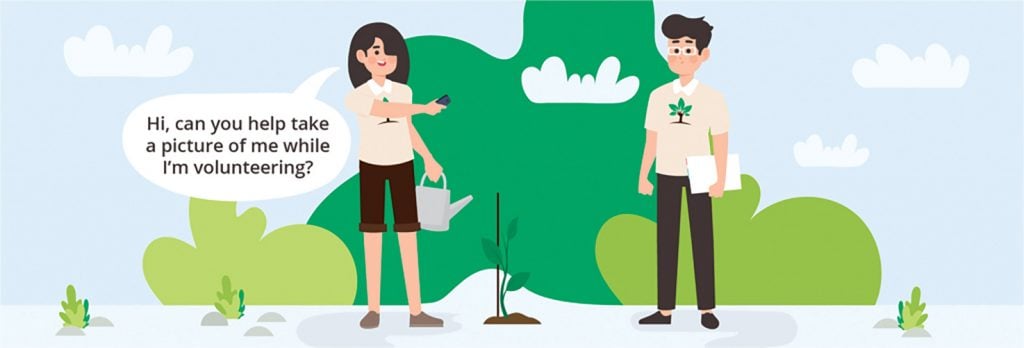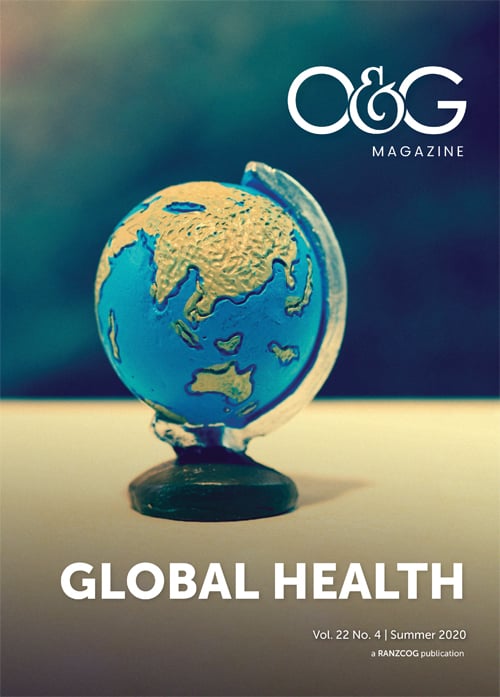On arrival at the hospital, she met the only local O&G consultant and was taken on a tour of the birth suite. Julie was surprised by how busy the staff were – there didn’t seem to be enough of them to manage all the labouring women!
As the consultant was required to attend a hospital meeting, Julie was left as the only doctor on the birth suite. The staff seemed overwhelmed, so she decided to assist by performing examinations, administering medications and undertaking simple clinical tasks such as cannula insertion.
Having enjoyed her experience, she returned the next day in the hope of more extensive involvement in patient care. Some of the obstetric cases were really challenging, and everyone seemed so grateful for her help and advice!
Global health volunteering is growing in popularity. While volunteers can make valuable contributions to international development, poorly executed assignments carry a risk of harm. This article considers the good, the bad and the ugly of international volunteering in global women’s health (GWH), and highlights the ethical challenges associated with voluntourism.
Volunteering and voluntourism
Volunteering for international development involves voluntary participation, without monetary reward, in activities that support sustainable development priorities. Best-practice programs focus on locally identified needs, and are undertaken in partnership with the host community.1
This model of volunteering stands in contrast to voluntourism, a form of travel in which tourists participate in unpaid work. Although there is no agreed definition, voluntourism is sometimes referred to as ‘holidaying with a purpose’.
Participants in voluntourism typically engage in brief, one-off activities that are not associated with longitudinal, capacity development programs. Stereotypical examples include foreign tourists visiting orphanages or schools in low- and middle-income countries (LMICs).2
In global health, activities that potentially constitute voluntourism include medical electives; delivery of donated medical equipment; and ‘missions’ to perform service delivery, teaching or research in developing settings.3 4 Whether or not these ‘short-term experiences in global health’ (STEGH) are ethically justified depends on both individual and program factors.5
The case study above illustrates voluntourism in GWH. While Julie’s desire to assist is admirable, ‘helping’ in this way is ethically complex. She, like other voluntourists, may inadvertently do harm in various ways, which could outweigh any short-term benefits.6 7 Ethically, good intentions are not enough – the principle of beneficence requires actions that actually translate into positive outcomes (or at least have a high probability of doing so, based on evidence and experience).
The good
The benefits of responsible global health volunteering are well documented.8 9 For host communities, the positive effects extend to patients (eg. access to medical services provided by skilled volunteers) as well as health professionals (eg. enhanced capacity through teaching and training). As discussed below, benefits are maximised when volunteering arrangements conform to best practice, and are associated with reciprocal, longitudinal development programs.
For volunteers, commonly reported benefits include improved cross-cultural understanding and a deeper appreciation of the social determinants of health. Additionally, volunteering assignments provide an opportunity to gain skills in resource-limited clinical care.10 11
In O&G, some clinicians participate in STEGH to gain exposure to surgery and pathology that is rarely encountered at home. An example is the practice of doctors from high-income countries travelling to Africa to perform obstetric fistula repairs.12 Missions of this nature require close scrutiny to ensure they are ethically justifiable. Any benefits to foreign volunteers should be considered an ‘added bonus’, not the justification for the volunteering activity.

Image by SOLS 24/7 via ‘Voluntourism – What’s Wrong With It?’
The bad and the ugly
Volunteering programs that lack robust design, implementation and monitoring arrangements have the potential to cause harm. STEGH, as opposed to long-term volunteering for international development assignments, are more likely to fall into this category.
There are a number of specific risks relevant to GWH. At a clinical level, patients might suffer if they receive care that is inappropriate in the context. For example, imagine that Julie encountered a woman in labour with a complete breech, and arranged a caesarean section. While this may be an appropriate course of action in a developed setting, in a resource-limited environment, operative delivery would place the mother at a significantly increased probability of death. The risk of maternal mortality following caesarean section in a LMIC is 100 times greater than in a high-income country, mostly related to postpartum haemorrhage and sepsis.13
Clinical risks are amplified when volunteers act beyond their scope of practice and do not seek local credentialing or registration. This practice is unfortunately common, and is more likely to occur in the context of poorly supervised programs.14 The ephemeral nature of STEGH also contributes to this risk, because short-term assignments do not allow the volunteer to develop an adequate understanding of local approaches and culture. This is particularly important in GWH because sensitive areas of reproductive health practice, such as contraception and termination, are heavily influenced by religious and cultural norms. Failure to acknowledge resource limitations can also be problematic, leading to unintended consequences with clinical implications (Table 1).
Table 1. Potential unintended consequences in GWH volunteer activities.
| Activity | Potential unintended consequences | Mitigation strategies |
| Stand-alone, surgically oriented visit involving service delivery +/- surgical mentoring | Consumption of local surgical equipment (eg. sterile drapes and other surgical consumables), compromising capacity for other operations and procedures
|
Ensure adequate planning, including extensive consultation with all local collaborators
Co-ordinate with other visiting surgical teams The team brings their own drapes and equipment, ensuring they don’t create a disposal burden for the host community |
| Stand-alone, education-focussed visit involving short course training | Removal of clinicians from clinical duties, leaving no one available to provide service delivery | Plan and collaborate with local partners
Develop an attendance roster and run several iterations of the program so that all relevant clinicians can attend the training |
| Visit to donate medical goods and equipment | Costs for maintenance and/or disposal are prohibitive
Undermining of local procurement processes, breeding dependence Equipment can’t be used because of poor access to consumables, a reliable power supply or appropriately trained staff |
Follow best practice guidelines in medical equipment donations |
At institutional level, poorly executed STEGH can be burdensome for host communities and undermine local capacity. In addition to the tangible harms described above, these types of practices serve to disempower communities and perpetuate a sense of dependence.15 Alongside improved health, respecting and promoting the autonomy of host communities is an important ethical goal in itself. Poor volunteering behaviours arguably perpetuate a neo-colonial approach to global health, amplifying power imbalances and compromising local ownership.16 17
Does this paint too bleak a picture of voluntourism? After all, as Julie might say, ‘Surely some help is better than none’. The problem is that Julie, and other voluntourists, are blind to the hidden long-term adverse effects, such as creating a belief among host communities that local providers are ineffective.18 These impacts accumulate, such that they can outweigh any short-term benefits for individual patients or local clinicians.
Advocates of voluntourism might also contend that communities can always decline the volunteer if they are concerned about long-term effects, but this ignores the fact that many host communities lack sufficient autonomy to refuse external support.19 Additionally, in high-context and relationships-based cultures (where meaning is often communicated through non-verbal cues and implicit messaging), individuals may say ‘yes’, but actually mean ‘no’.20
Voluntourism also carries risks for the volunteer. Clinicians who engage in poorly designed volunteering programs potentially leave themselves vulnerable, especially in the setting of volatile workplaces and limited cultural understanding.21 22 For Julie, specific risks might include needle-stick injury and confrontation with local staff members. While accepting some level of risk to self in order to help others is a good thing (and arguably part of the internal morality of medicine), taking on risk to self when it might do more harm than good to others just doesn’t make sense.
Towards responsible volunteering
For these reasons, it is vital that the GWH community adopts high ethical standards in relation to international volunteering. O&G practice, by its nature, involves care of vulnerable patient groups, and GWH programs must ensure women and their communities are protected.
It is also important that senior O&G clinicians set the right example for junior colleagues. A recent survey of O&G trainees in Australia and New Zealand identified that 88% were interested in undertaking GWH work in the future. This finding has stimulated valuable discussion regarding the need for ethically robust GWH training programs.23
Fortunately, clear standards for international volunteering have been developed by the Australian Council for International Development.24 Additionally, several other guidelines are available to inform safe approaches to STEGH and global health training.25 26
Shah et al, for instance, have published a framework that seeks to optimise outcomes and mitigate risks from STEGH.27 They suggest a principles-based approach with individual and program-level responsibilities.
At individual level, volunteers should be culturally sensitive; join programs with long-term work plans; thoroughly understand local context and guidelines; arrange all appropriate registrations and insurances; and possess the requisite clinical skills and experience, with insight to their limitations. Meanwhile, programs must have clearly articulated objectives; focus on capacity building; facilitate collaboration with local clinicians and other visiting programs; recruit volunteers with appropriate skills and attributes; ensure participant preparation and debriefing; and regularly evaluate their performance.28
There are many opportunities for GWH volunteering that are consistent with these principles. These include deployments through established humanitarian organisations (such as Médecins Sans Frontières), College-linked surgical projects (such as the Pacific Island Program) and long-term development initiatives through the Australian Government. One such model, supported by RANZCOG, is profiled in Box 1.
Solomon Islands Graduate Intern Support and Supervision Project (SIGISSP)
SIGISSP places advanced trainees with RANZCOG (and other speciality training programs) at the National Referral Hospital in Honiara, Solomon Islands, for 6–12-month terms. Trainees provide ward-based supervision for junior doctors, contribute to teaching programs for Cuban-trained interns and participate in quality improvement activities. Trainee-led quality improvement projects have included the development of a National Standard Treatment Manual in O&G and a comprehensive audit process for maternal mortality. The program is facilitated by Australian Volunteers International and funded by the Australian Government through the Australian Volunteers Program.29
Conclusion
As interest in GWH increases, it is essential that the O&G community maintains high standards in international volunteering. Volunteers can make valuable contributions, but only if they participate in robust programs that emphasise mutuality and sustainability. By following best practice guidelines, O&G clinicians can ensure their GWH activities are safe, ethical and effective.
References
- Australian Council for International Development. ACFID Practice Note. Responsible International Volunteering for Development. Available from: https://acfid.asn.au/sites/site.acfid/files/resource_document/ACFID Practice Note- Volunteering for International Development.pdf.
- Australian Council for International Development. ACFID Practice Note. Responsible International Volunteering for Development. Available from: https://acfid.asn.au/sites/site.acfid/files/resource_document/ACFID Practice Note- Volunteering for International Development.pdf.
- Martiniuk ALC, Manouchehrian M, Negin JA, Zwi AB. Brain Gains: a literature review of medical missions to low and middle-income countries. BMC Health Serv Res. 2012;12:134. doi:10.1186/1472-6963-12-134
- Melby MK, Loh LC, Evert J, et al. Beyond Medical “Missions” to Impact-Driven Short-Term Experiences in Global Health (STEGHs). Acad Med. 2016;91(5):633-8. doi:10.1097/ACM.0000000000001009
- Shah S, Lin HC, Loh LC. A Comprehensive Framework to Optimize Short-Term Experiences in Global Health (STEGH). Global Health. 2019;15(1):1-8. doi:10.1186/s12992-019-0469-7
- Melby MK, Loh LC, Evert J, et al. Beyond Medical “Missions” to Impact-Driven Short-Term Experiences in Global Health (STEGHs). Acad Med. 2016;91(5):633-8. doi:10.1097/ACM.0000000000001009
- Shah S, Lin HC, Loh LC. A Comprehensive Framework to Optimize Short-Term Experiences in Global Health (STEGH). Global Health. 2019;15(1):1-8. doi:10.1186/s12992-019-0469-7
- Australian Council for International Development. ACFID Practice Note. Responsible International Volunteering for Development. Available from: https://acfid.asn.au/sites/site.acfid/files/resource_document/ACFID Practice Note- Volunteering for International Development.pdf.
- Mitchell RD, Jamieson JC, Parker J, et al. Global health training and postgraduate medical education in Australia: the case for greater integration. Med J Aust. 2013;198(6):316-9. doi:10.5694/mja12.11611
- Mitchell RD, Jamieson JC, Parker J, et al. Global health training and postgraduate medical education in Australia: the case for greater integration. Med J Aust. 2013;198(6):316-9. doi:10.5694/mja12.11611
- Mitchell R, Mitchell R, Phillips G, Jayaratnam S. Demand for global health training among obstetrics and gynaecology trainees in Australia and New Zealand: Insights from the TIGHT study. ANZJOG. 2020;60(4):616-21. doi.org/10.1111/ajo.13122
- Wall LL, Arrowsmith SD, Lassey AT, Danso K. Humanitarian ventures or “fistula tourism?”: The ethical perils of pelvic surgery in the developing world. Int Urogynecol J. 2006;17(6):559-62. doi:10.1007/s00192-005-0056-8
- Sobhy S, Arroyo-Manzano D, Murugesu N, et al. Maternal and perinatal mortality and complications associated with caesarean section in low-income and middle-income countries: a systematic review and meta-analysis. Lancet. 2019;393(10184):1973-82. doi:10.1016/S0140-6736(18)32386-9
- Shah S, Lin HC, Loh LC. A Comprehensive Framework to Optimize Short-Term Experiences in Global Health (STEGH). Global Health. 2019;15(1):1-8. doi:10.1186/s12992-019-0469-7
- Australian Council for International Development. ACFID Practice Note. Responsible International Volunteering for Development. Available from: https://acfid.asn.au/sites/site.acfid/files/resource_document/ACFID Practice Note- Volunteering for International Development.pdf.
- Australian Council for International Development. ACFID Practice Note. Responsible International Volunteering for Development. Available from: https://acfid.asn.au/sites/site.acfid/files/resource_document/ACFID Practice Note- Volunteering for International Development.pdf.
- Pai M. 10 Fixes for Global Health Consulting Malpractice. Global Health Now. Available from: www.globalhealthnow.org/2019-08/10-fixes-global-health-consulting-malpractice.
- Rozier M. Ethics of Short-Term Experiences in Global Health: Engaging Skeptics of Change. Ann Glob Heal. 2019;85(1):1-2. doi:10.5334/aogh.2529
- Rozier M. Ethics of Short-Term Experiences in Global Health: Engaging Skeptics of Change. Ann Glob Heal. 2019;85(1):1-2. doi:10.5334/aogh.2529
- Goman CK. How Culture Controls Communication. Forbes. Available from: www.forbes.com/sites/carolkinseygoman/2011/11/28/how-culture-controls-communication/#4d066dae263b.
- Australian Council for International Development. ACFID Practice Note. Responsible International Volunteering for Development. Available from: https://acfid.asn.au/sites/site.acfid/files/resource_document/ACFID Practice Note- Volunteering for International Development.pdf.
- Mitchell RD, Jamieson JC, Parker J, et al. Global health training and postgraduate medical education in Australia: the case for greater integration. Med J Aust. 2013;198(6):316-9. doi:10.5694/mja12.11611
- Mitchell R, Mitchell R, Phillips G, Jayaratnam S. Demand for global health training among obstetrics and gynaecology trainees in Australia and New Zealand: Insights from the TIGHT study. ANZJOG. 2020;60(4):616-21. doi.org/10.1111/ajo.13122
- Australian Council for International Development. ACFID Practice Note. Responsible International Volunteering for Development. Available from: https://acfid.asn.au/sites/site.acfid/files/resource_document/ACFID Practice Note- Volunteering for International Development.pdf.
- Shah S, Lin HC, Loh LC. A Comprehensive Framework to Optimize Short-Term Experiences in Global Health (STEGH). Global Health. 2019;15(1):1-8. doi:10.1186/s12992-019-0469-7
- Crump JA, Sugarman J, Barry M, et al. Ethics and best practice guidelines for training experiences in global health. Am J Trop Med Hyg. 2010;83(6):1178-82. doi:10.4269/ajtmh.2010.10-0527
- Shah S, Lin HC, Loh LC. A Comprehensive Framework to Optimize Short-Term Experiences in Global Health (STEGH). Global Health. 2019;15(1):1-8. doi:10.1186/s12992-019-0469-7
- Shah S, Lin HC, Loh LC. A Comprehensive Framework to Optimize Short-Term Experiences in Global Health (STEGH). Global Health. 2019;15(1):1-8. doi:10.1186/s12992-019-0469-7
- Mitchell R, Mitchell R, Phillips G, Jayaratnam S. Demand for global health training among obstetrics and gynaecology trainees in Australia and New Zealand: Insights from the TIGHT study. ANZJOG. 2020;60(4):616-21. doi.org/10.1111/ajo.13122








Leave a Reply